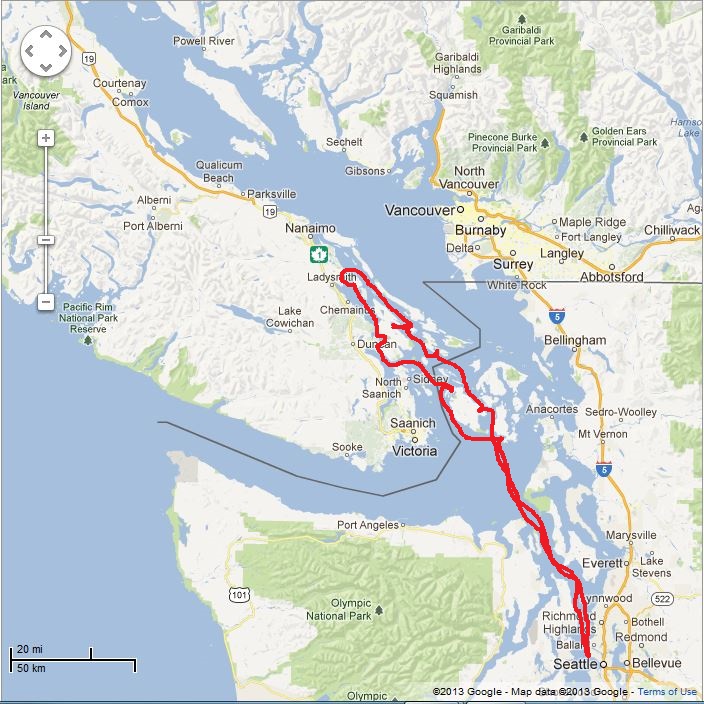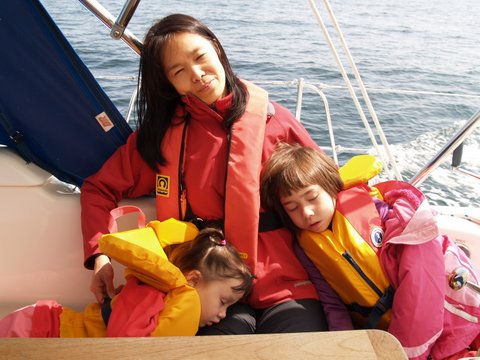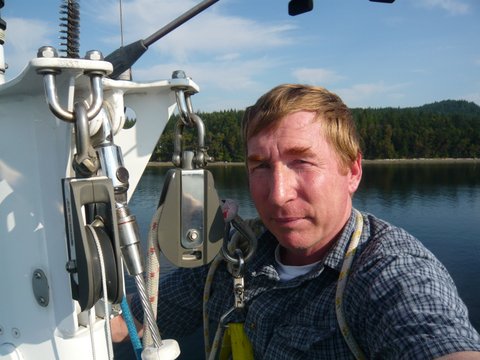- Boat
- Articles
- About
- Tehani-li Logs
- 2004
- Uligan Maldives
- Man, Oh Man, Oman
- Eritrea: The Nicest Place You’ve Never Heard Of
- Cruising Notes: Oman to Eritrea – From Pirates to Cappucinos
- Old Testament Sudan
- Egypt: Legend, Myth and Reality
- Thoughts on Cruising the Red Sea
- Greece: Civilization Again
- Montenegro
- Malta
- Sardinia, Italy
- Barcelona, Spain
- 2003
- 2002
- 2001
- 2004
- Contact
Maiden Voyage in the Salish Sea

Six months after the fact I figure it’s about time to write about our first trip on Asmara Sky. I have been a little busy so this has not received the attention it deserves. We have made many smaller trips since our first but this was our maiden voyage, up to the San Juan Islands and Canada’s Gulf Islands, and it requires a separate post.
I had been working on the boat all summer and my last glamorous job, replacing the two toilets, was finally complete. Both shitters flushed. It was time to go. Sailing, that is. We just had two weeks off, like most working class morons, so the San Juan Islands were the destination. I also wanted to go further north and see the Gulf Islands in BC, if time permitted. My original plan had been to go to Barkley Sound on Vancouver Island’s west coast but with the girls, Asmara, age 6 and Adriana, age 3 we went for the easier protected way. Since we hadn’t seen anything of our new home wherever we went was going to be great, even if it was a wuss move.
First anchorage
Whether you head out on a boat for two weeks or two years, it requires almost the same amount of preparation. This was demonstrated by the fact we didn’t even leave the dock at Elliott Bay in Seattle until 3:30 PM. We motored north up the sound for two hours to Kingston and anchored in Appletree Cove. This was our first time anchoring the new (to us) boat AND I had just put on a brand new, bright yellow Spade 110 LB anchor with two brand new bright and shiny Crosby shackles both wired shut. We were ready for Appletree Cove. Like everywhere in Puget Sound the bottom was thick, oozy mud and the anchor dug in as soon as it hit. Works as advertised, I thought with satisfaction.
The anchorage was a little rolly due to the constant coming and going of the Edmonds ferry but we passed a quiet night undisturbed. Even though it was nothing exciting the anchorage was special and I savored the moment of our first night at anchor with the family on board.
First light
At first light all was still and the girls were fast asleep. Ariel took the helm and I went to the windlass to haul up the anchor and half a ton of mud. We pointed the bow north and on a windless summer morning motored toward our destination with the rising sun to starboard. Today we would try to cross the “much feared” Juan de Fuca Strait that separates Canada and the US. (Actually, having gone to university in Canada I can say a lot more than the strait separates the two countries, but that is another story).
Many local sailors and boaters I had talked to prefer to take a longer route to the San Juans by staying in protected water and motoring up behind Whidbey Island. We had a beautiful day and decided, nope, that wasn’t for us. At 11:00 am sharp the sailing vessel Asmara Sky left the protected water of Puget Sound and entered the strait. We plunged through pea soup-thick fog and we had to dodge an Alaskan freighter (“Midnight Sun”) as well as a nice Valiant 40 (“Fanuei” of Portland) coming at us through the murk. We have radar and it worked, so there were no worries on either count.
There was about 10 knots of wind, which died leaving us to motor through some chop causing the boat to bounce a bit. The stout crew started to get green around the gills. Here is my favorite photo of the whole trip taken in the middle of the strait:

The crossing was easy enough and we motored through “much feared” Cattle Pass into the quiet waters of San Juan Island. We dropped the hook in Friday Harbor at 3:30 pm. We like dropping the anchor so much we anchored FOUR times until she set. Friday Harbor is a deep anchorage (50-60 feet) and the holding was not good. We spent two days hanging out there and saw quite a few other boats anchor and re-anchor. My view on anchoring is I don’t care how many times it takes to get it right; if the anchor isn’t set hard then I try again. And again. Our record for “re-anchoring” is 13 times at Port Blair, in the Andaman Islands, India. That was in the tropics and by the end of it I was soaked with sweat and the air was soaked with salty language. (The incident made me start thinking of upgrading our CQR anchor, which I have done with Asmara Sky and am very happy with the decision so far).
It was a strange experience to us newbies to have float planes landing and taking off in front of our little anchored home. Friday Harbor is very picturesque but since it was peak season it felt a little crowded. Two nights there was enough and we moved to Bedwell Harbor, on South Pender Island to check into Canada. Our first check in to Canada turned out to be rather farcical.
Comedy of errors
The anchorage is very straightforward. We came in and enacted a procedure common around the rest of the world and one we have done dozens of times across Southeast Asia, India, Sri Lanka, the Middle East and Europe. But NOT in Canada. We raised our yellow Q flag when we crossed into Canadian water, we anchored and the captain took the boat’s papers to shore in the dinghy while the rest of the crew stayed aboard. I waited in line with other sailors to use the two phones there to call Customs Canada. I thought it strange we were the only boat in the anchorage with a Quarantine flag up, and there were probably a good 30 boats coming and going from the busy docks. My turn on the phone. Yes, my name is Derek Hillen and we have just arrived from Friday Harbor with four people on board. No, we are not at the dock, we are anchored. This set off a shit-storm.
Sacred soil
I learned in short order that your anchor is, “not allowed to touch Canadian soil until you have cleared in to the country!” Yikes, I guess there is something special about Canadian dirt but it looked like dirt I’ve seen in other places. “Why did you do that? What are you thinking?” the customs agent demanded on the other end of the phone. Well, I thought (like every country on the planet) customs officials wanted to come out to the boat, I tried to explain. I was cut off with uncharacteristic Canadian sarcasm, “How? Swim?”
I had read ALL the books on the Gulf Islands, including Exploring the San Juan and Gulf Islands, A Cruising Guide to Puget Sound, and the San Juan Islands and The Waggoner Cruising Guide, and had them on board. I don’t remember ANY of them explaining that you HAD to dock the boat to check into the country. They were great on all the other dull details; you must have a passport, you must have boat ownership papers, you must not shoot any locals, etc. But they just LEFT OUT the most important part of the whole tiresome procedure.
I went back to the boat, took down the damn flag (nobody here knows what it is – I even had another sailor ask me about it), upped the anchor with the normal half ton of mud and we motored to the dock. I don’t like docking if it can be avoided. We have a relatively large vessel, 54 feet long overall and 25 tons in weight. Many docks are designed for smaller, more maneuverable boats. This one was no different but we managed to squeeze in and get tied up.
Check in complete, we untied ourselves from the dock and motored back to the exact spot where we had just anchored – and dropped the hook again in 12 meters. We spent the night in Bedwell Harbor and explored the little resort there, Poets Cove. I bought a six pack of Canadian beer to ease my troubles and after the girls got tired of throwing stones into the water from the beach we dinghied back to the mother ship to spend a quiet night with me nursing my Molson Canadians.

The next morning we took a short jaunt up to Prevost Island and anchored in James Bay, a small area that already had three other boats there. Taking the dinghy ashore allowed us to stretch our legs and do some walking on the pretty trail that goes around the bay. This was the only bay we visited that didn’t have houses perched around it staring at us – and we still had to share it with other boats. At least there were no float planes landing right next to us.
The next day after one hour of motoring found us in Ganges, Saltspring Island – anchored beside the float planes coming and going. Ganges in the summer is a busy little place but we spent two days there in the noisy anchorage and enjoyed the town. I was hoping for some good Indian food given the name but, no, Ganges was named after HMS Ganges, the last sailing ship of the line in foreign service, no curry to be found.
August 17th would see us reach the most northern point of our journey as we rounded the top of Thetis Island and anchored in Preedy Harbor, where I went up the mast to replace bulbs in our tricolor. Preedy was a unique place as the seals there continually surfaced, rotated and slapped the water with their flippers all night long. The bay was very still and peaceful and then…SLAP the jolting sound would race across the water. A few minutes later another SLAP echoed from a different point in the bay. It seemed to be some way of scaring fish and was quite unique to watch. Asmara and I sat in the cockpit as the sun set with the binoculars enjoying the slap show.
Meeting our first asshole
While the wildlife was entertaining our interaction with the locals was less so. We took the dinghy into Telegraph Harbour Marina to get some gas and have lunch in the restaurant ashore. I pulled up slowly to the dinghy fuel dock with the girls on board and before I could say hello I was met by a rough geezer in torn shorts who barked, “$10 if you stay more than an hour at the dock!”
Wow, I thought. What an asshole. We come to spend money at the resort including buying gas for the dinghy from them and this is the welcoming committee. I guess the summer for him was wearing as thin as his manners. We shrugged it off and walked up a little grass knoll to the café where the people inside were very nice and had a bite to eat. The resort had signs advertising their Wi-Fi and after asking if it worked I was assured it did. We came back the next day with the laptop to check email but upon asking for the login information – after ordering again at the café – we were told that unless we were staying at the tiny marina we couldn’t use it! Spending money there didn’t matter. I even offered to pay to use the Wi-Fi but no, that wouldn’t do for some unknown reason which only made sense to them. The woman in charge of the café politely suggested I take my laptop and walk a mile or two down the road to the library and use it there. Amazingly, she continued, “Now what are you having for lunch?”
Places like this always struggle because they can’t figure out that if you actually help people it comes back to you in a virtuous circle. Trying to screw the next guy out of every last loonie is a poor business strategy. Telegraph Harbour Marina is permanently off our list of destinations to recommend to people we like.
We rode the dinghy through the narrow “cut” that divides the island. The ride was pretty and with the southern side of the cut being Indian land there was no development and it looked very much like I thought it would have 300 years ago.

It was time to start thinking about heading back. Leaving Thetis Island early in the morning, we managed to actually get the sails up and had 13 knots of wind on a beam reach. This was great for the 59 minutes it lasted. Then the wind naturally backed until it was dead on the nose and shortly afterward it just died completely. On came the iron genny and we had a very picturesque motor sail through the dramatic Samsun Narrows, arriving in Roche Harbor on San Juan Island at noon to check back into the US.
Getting some old guys in trouble
Having learned my lesson in Canada, I figured US Customs would want us to dock so we threaded our way through the very crowded anchorage to the docks where dozens of boats of all sizes were coming and going. These docks were long, straight and easy to approach – if you could dodge the other traffic and the float planes. We circled patiently for around ten minutes until a space opened up that was large enough for our boat. As we approached a 35 foot sailboat nipped in front of us and took our place! I was angry and slowed down, passing next to them and shouted, “Hey, thanks for taking my spot, guys!” Two old farts looked up in shock. I could see they hadn’t seen me and it was a mistake. I instantly felt bad (but what the hell) and proceeded to turn the boat around and wait for another opening.
To their credit, both elderly gents jumped off their boat onto the dock to push their craft forward as far as they could thus opening up a spot for me. That was thoughtful. What wasn’t so thoughtful was the fact that ONLY the captain of the vessel is allowed to disembark until clearance has completed. Customs were all over these guys, “Who’s the captain? What are you doing off the boat?” They demanded of the confused crewman. We could hear everything as we tied up behind them. I walked up to the well-armed Custom’s officer and explained what they were doing. It didn’t help.
We checked in and learned Roche Harbor is the busiest crossing point for boats in the entire US. The officials were very professional. The officer took my passports and wanted to come aboard to match faces to the documents. And that was it, we were free to go. In the meantime, the old guys behind us were just getting into more and more trouble. One of them had forgotten his passport and the boat didn’t have up to date registration decals. Some days you win and some days…

We pulled away from the dock and motored into 2-3 foot seas and 13 knots of wind as we rounded the top of San Juan Island. This is where the killer whales are supposed to be and although a sharp watch was maintained, we saw nary a fin. We anchored in mill pond calm Mackaye Harbor on Lopez Island in the early evening, a very protected anchorage and spent the quietest night at anchor yet.
Note to self: Pay attention to the tide
Our last day we motored across the strait with no problem at all and then fought 3 knots of adverse tide when we passed Admiralty Inlet at the entrance to our home waters of Puget Sound. Motoring all day under clear skies and no wind brought us back to Elliott Bay Marina mid-afternoon. All in all we put 44 hours on the engine for the trip and 10 hours on the generator. I burned about 82 gallons of diesel and learned a lot about how the boat works. We enjoyed our trip through the San Juans and Gulf Islands as it is very pretty country and almost everyone you meet is nice. However, in August it seems all anchorages that we visited are crowded and every island we passed is jammed with houses. I hear from others with more experience that there are many places that don’t fit the above description which means we are looking forward to another trip there to explore further.
Our sailing plans this summer (2013) include a destination not so easily visited and one for which we have now been busily preparing for almost a year.

